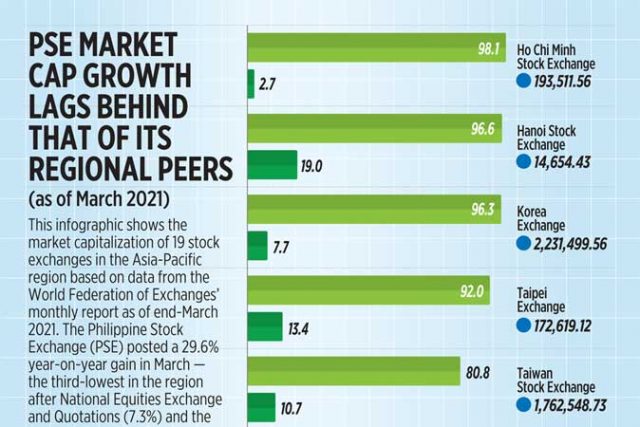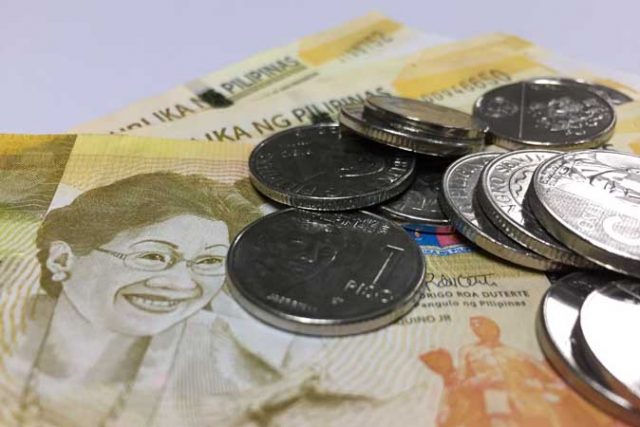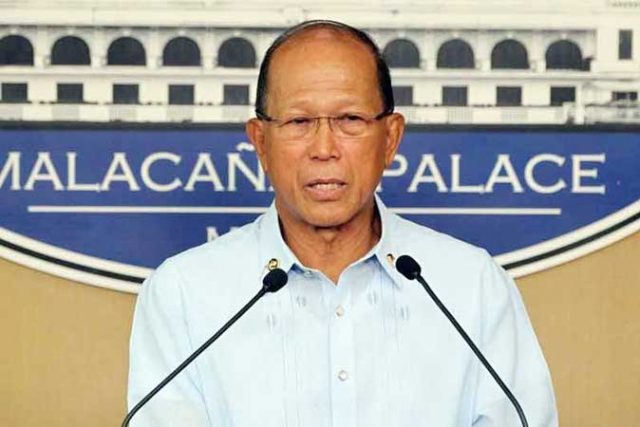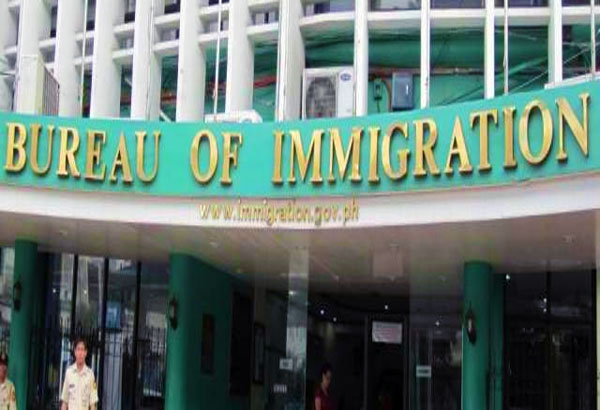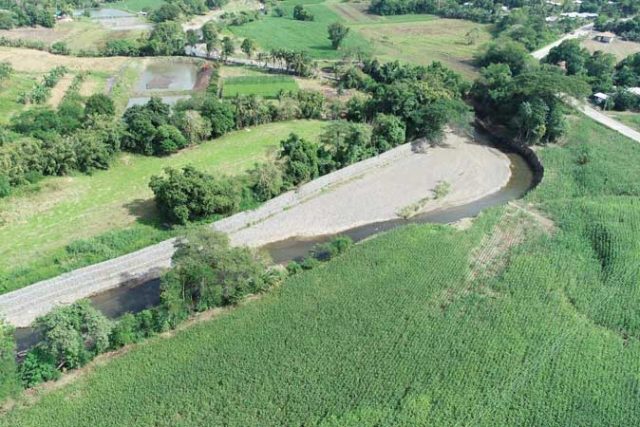Peso may weaken vs dollar on Fed meeting, budget balance data
THE PESO could weaken versus the dollar this week as the market awaits the release of the government’s latest budget balance data and the US central bank’s rate decision.
The local unit closed at P48.381 per dollar on Friday, appreciating by 2.9 centavos from its P48.41 finish on Thursday, based on data from the Bankers Association of the Philippines.
Meanwhile, it barely moved from its P48.38 finish a week earlier.
The peso strengthened against the greenback last week after the government closed its offering of euro-denominated bonds, Rizal Commercial Banking Corp. Chief Economist Michael L. Ricafort said.
The Bureau of the Treasury last week raised €2.1 billion in fresh funds via euro-denominated bonds with tenors of four years, 12 years, and 20 years.
Another factor that contributed to the peso’s strength was the decline in US Treasury yields, UnionBank of the Philippines, Inc. Chief Economist Ruben Carlo O. Asuncion said.
For this week, Mr. Asuncion said the market will take its cue from the US Federal Reserve’s monetary policy decision at its meeting on April 27-28.
Fed Chair Jerome Powell has primed investors to fear no surprises from the central bank’s two-day meeting ending Wednesday, when officials are expected to keep interest rates near zero and signal no change in their $120-billion-a-month pace of bond purchases, Bloomberg reported
Mr. Powell, who will hold a press conference after the decision, has balanced optimism by warning the economy remains at risk from the coronavirus disease 2019 (COVID-19) globally. Officials in March signaled they expect to hold rates steady through 2023.
Meanwhile, Mr. Ricafort said investors will also watch out for the March budget balance data, which the Bureau of the Treasury is scheduled to report on Tuesday.
The government’s budget deficit more than tripled to P116 billion in February from a P37.6-billion fiscal gap a year earlier, as the surge in spending outpaced the uptick in revenues.
For this week, Mr. Ricafort gave a forecast range of P48.25 to P48.55 per dollar while Mr. Asuncion expects the local unit to move within the P48.20 to P48.50 band. — L.W.T. Noble with Bloomberg
Shares may drop as market awaits new restrictions
PHILIPPINE shares may continue their downward trend this week as the country reports more coronavirus disease 2019 (COVID-19) infections, raising fears that strict restrictions would be extended.
The Philippine Stock Exchange index (PSEi) declined by 37.46 points or 0.58% to finish at 6,378.07 on Friday, while the broader all shares index lost 20.22 points or 0.51% to end at 3,927.19.
Week on week, the benchmark index shaved off 116.74 points from its 6,494.81 close on April 16.
“The market suffered more losses [last] week as more and more investors are closing positions on expectations that the economy will take longer to recover,” AAA Southeast Equities, Inc. Research Head Christopher John J. Mangun said via e-mail.
“The spike in new COVID-19 cases, locally and abroad, has caused tighter restrictions and fears of financial hardships,” Mr. Mangun added. “The slow pace of inoculation is another reason why investors are turning increasingly bearish.”
He added that developments this week will be “extremely important” for the market.
“We may see an extension of the current measures as the number of new cases have not shown any improvement. Further tightening of mobility will be a disaster for the economy as well as the market,” Mr. Mangun said.
The National Capital Region and nearby provinces have been under strict lockdown for the past month as coronavirus cases surged, with a decision on an extension or easing expected by April’s close.
The Health department on Saturday reported 9,661 new COVID-19 infections, which brought the country’s tally to 989,380. Active cases stood at 89,485. The department said on Saturday that more vaccines were set to be distributed to local government units yesterday.
“If we see a significant decline from this, then it may fuel optimism in the market. A surge from the said daily average COVID-19 cases may lead to otherwise, however,” Philstocks Financial, Inc. Senior Research Analyst Japhet Louis O. Tantiangco said in a Viber message on Sunday.
“Investors are [also] expected to look towards the [first-quarter] 2021 corporate earnings reports for clues on how companies are faring amid the lingering challenges brought by the COVID-19 pandemic,” Mr. Tantiangco added.
He said he expects the PSEi to end between the 6,370 to 6,400 range, with support pegged at 6,100.
“Market will continue its downtrend due to [sustained] high level of infection rates at four digits or above coupled with slow vaccine rollout that may serve as hindrance for the government to normalize the economic condition,” Diversified Securities, Inc. Equity Trader Aniceto K. Pangan said in a mobile phone message on Saturday. — Keren Concepcion G. Valmonte
Duterte wrong on fish data — political analysts
By Kyle Aristophere T. Atienza, Reporter
THE SOUTH China Sea is a major fish source for the Philippines that is crucial to its food security, political analysts said on Sunday, belying President Rodrigo R. Duterte’s claim that it couldn’t quarrel with China over fish.
China’s unregulated fishing activities in the disputed waterway, where the Southeast Asian nation gets 27% of its fish catch, threatens the livelihood of thousands of Filipino fishermen, said Sheena A. Valenzuela, a national security analyst at the Ateneo De Manila University Policy Center in Manila.
“It’s resources are crucial to the food security of Filipinos, contributing to coastal livelihoods and export trade,” she said in an e-mail. China’s illegal fishing activities “could also lead to the loss in livelihood of about 627,000 Filipino fishermen.”
Mr. Duterte last week said he would only send warships to the South China Sea once China starts drilling for oil in the area, noting that there was not enough fish there to quarrel about.
“There is no treaty between the Philippines and China allowing the latter to fish within the Philippine exclusive economic zone, which means China’s actions are illegal,” Ms. Valenzuela said.
The South China Sea has been the source of about 12% of global fishery production and hosts more than half of the world’s fishing vessels, Jay L. Batongbacal, who heads the University of the Philippines Institute for Maritime Affairs and Law of the Sea, said in a Viber message.
Fishery production from the waterway was worth $617.18 million in 2016, he said. “But we don’t know how much more this figure could be had we been tracking how many foreign fishing vessels have been operating in the South China Sea and how much they are taking.”
Mr. Batongbacal said there is no exact fish data, which are based on fish landing at fish ports, not on fishing grounds where the fish came from. “The governance system does not account for where fishermen go.”
INCOME LOSS
Annual yield from the Spratly Islands alone could reach as high as 90.8 thousand metric tons (MT) a year, which is equivalent to 5% of the country’s total marine capture, he added.
“The fish stocks there are indeed vital to the country’s economic sustenance and development,” the analyst said.
The South China Sea is biologically linked to the Sulu Sea and the rest of the Coral Triangle that extends all the way to Papua New Guinea, Mr. Batongbacal said. “It plays a role in the regeneration of fish stocks in those other waters.”
“The possible income loss from conceding our marine resources there is about P4-5.9 billion per year,” Jerwin G. Baure of scientist group AGHAM said in a Facebook Messenger chat.
Mr. Baure, a fishery technologist, said the South China Sea supports as many as 3.7 million fishermen from six countries.
“Around 55% of the fishing vessels in the world operate in the South China Sea, on which 86% are small-scale fishing vessels,” he said.
Mr. Baure said Chinese island-building activities had destroyed at least 16,000 hectares of reefs as of 2017. Reef damage could reach P33.1 billion yearly.
More than 1,500 fishermen in Masinloc, Zambales in northern Philippines have deserted the Scarborough Shoal, which for decades served as their traditional fishing ground, he said, citing fisherfolk group Pamalakaya.
About 240 Chinese vessels that China claims are ordinary fishing vessels have spread out to a wider area in the South China Sea, a Philippine border patrol task force earlier said.
It said about 15 vessels either manned by Chinese militia, the People’s Liberation Army Navy or Chinese Coast Guard had been spotted at the Scarborough Shoal.
Michael Henry Ll. Yusingco, a research fellow at the Ateneo De Manila University Policy Center, said the fishing ground in the South China Sea was one of the reasons why the Chinese and Vietnamese have invested in their fishing fleets.
“This begs the question, why have we not done the same?” he asked.
“Whatever claim the President has regarding this subject can easily be confirmed or disproved by the Bureau of Fisheries,” he said. “So the fact that the latter has not been vocal in this issue tells me a different story.”
The Bureau of Fisheries and Aquatic Resources did not immediately reply to a mobile phone message seeking comments.
Presidential spokesperson Herminio “Harry” L. Roque, Jr. last week said Mr. Duterte would tolerate China’s fishing activities in the South China Sea. He added that Filipinos could also fish freely in the contested waters.
“The fact that the Chinese militia has been exploiting our marine ecosystem without the proper legal framework in place is tragic on many levels,” Mr. Yusingco said.
Herman Joseph S. Kraft, head of the UP Political Science Department, said the President’s unwillingness to counter China’s military presence in the disputed waterway makes his administration culpable.
“He is dangerously abrogating to himself powers that compromise constitutional provisions,” he said of Mr. Duterte.
Renato C. de Castro, an international studies professor at De La Salle University, urged the government to build structures in its territories to deter Chinese incursions.
“I don’t know if the administration has the courage to do that, honestly, but we have to move fast to build structures,” he said in a Zoom App Meetings interview.
“Duterte is not actively upholding the arbitration case victory, as seen by his administration’s responses to Chinese vessel intrusion until recently,” Mr. Baure said.
“It seems that he has chosen to remain diplomatic to retain the Philippines’ bargaining position for China-funded infrastructure projects and other state donations, like vaccines,” he added.
Pandemic response to be part of national security plan — DND
PANDEMIC response would become a top national security priority, the country’s Defense chief said on Sunday, more than a year since the coronavirus pandemic started.
Government response to pandemics would be included in the country’s national security plan, Defense Secretary Delfin N. Lorenzana said in a Viber message. “This pandemic has clearly demonstrated that health should be a major concern of the government.”
“While we modernize our Armed Forces, there is a more compelling reason to modernize our health system as well,” he added.
The national security plan is a document that contains strategic policy goals and state objectives to protect the “well-being of its people and institutions and its sovereignty and territorial integrity,” according to the website of the National Security Council.
“It is a must to include pandemic response in the guise of disaster risk and resilience management because, with emphasis, the consequences of not preparing outweigh the cost of preparing,” John Paul R. Rivera, an economist at the Asian Institute of Management, said in a Viber message.
“Because we are not prepared for a pandemic, the lockdowns as a reaction to contain the pandemic cost the economy so much,” he said. “Not preparing may result in larger and unprecedented costs.”
The Department of Health (DoH) reported 8,162 coronavirus infections on Sunday, bringing the total to 997,523.
The death toll rose by 109 to 16,783, while recoveries increased by 20,509 to 903,665, it said in a bulletin.
There are 77,075 active cases, 1% of which were critical, 95.5% were mild, 1.5% did not show symptoms, 1.2% were severe and 0.84% were moderate.
The agency said 19 duplicates had been removed from the tally, 13 of which were tagged as recoveries. It said 52 recoveries were reclassified as deaths.
Two laboratories were closed April 23 and eight failed to submit data.
A panel at the House of Representatives last year approved a bill that seeks to create a permanent National Health Security Council that will formulate an emergency plan to handle public health emergencies.
Carlito G. Galvez, Jr., chief implementer of the country’s pandemic plan, earlier said the measure would complement the law on universal healthcare.
Mr. Rivera said the country’s national security plan should also focus on the creation of local vaccine manufacturing facilities.
Trade Secretary Ramon M. Lopez earlier said the government was in talks with at least four pharmaceutical companies that have expressed intent to set up vaccine manufacturing facilities in the country.
Mr. Rivera said the security road map should include pandemic prevention such as automatic border closures, travel advisories, and the deployment of health workers here and abroad.
The security plan should also consider social amelioration and the creation of systems to prevent, manage and contain a health crisis.
“We should have learned something from this pandemic to mitigate the ill effects on households, companies and the economy,” he said.
George T. Barcelon, president of the Philippine Chamber of Commerce and Industry, said making pandemic response part of the country’s national security plan would boost business confidence.
“It’s important that the security protocols by military or law enforcers on such matters be properly implemented with no intrusion on individual safety and freedom,” he said. — Kyle Aristophere T. Atienza
Farmers’ group files complaint vs agri chief
FARMERS’ group Samahang Industriya ng Agrikultura (SINAG) filed a complaint against Agriculture Secretary William D. Dar for his alleged failure to implement the country’s food safety regulations. The group led by its chairman, Rosendo O. So, filed the case at the Office of the Ombudsman on April 23 citing the “continuing failure” of Mr. Dar to enforce food safety standards and regulations under Republic Act (RA) No. 10611 or the Food Safety Act. “It had deleterious socio-economic effects: rampant misdeclaration of agricultural commodities; cases of African Swine Fever (ASF), Avian Flu, and foot-and-mouth disease, and other viral illnesses; and soaring food costs,” Mr. So said in the complaint. He cited the “Quarantine First Policy” under RA 10611 that requires imported food to undergo cargo inspection and clearance procedures by the Department of Agriculture (DA) and Department of Health (DoH) at the first port of entry. The policy also provides that the DA and DoH inspection should always be conducted before assessment for tariff and other charges by the Bureau of Customs (BoC). The DA, instead, has been examining imported food products after these have been transferred from the first port of entry, Mr. So said.
MORE PORK IMPORTS
“At the first port of entry, quarantine officers merely open shipping containers for a quick look and immediately close them to avoid spoilage or contamination. The containers are then brought to and examined at accredited warehouses,” he said. SINAG, he added, has repeatedly asked the DA and Mr. Dar to fully implement the first border inspection as mandated under the law. “Instead of heeding the request of the local agriculture sector, Mr. Dar moved to increase the minimum access volume (MAV) allocation for pork and reduce pork tariffs,” Mr. So said. Currently, the DA is using a two-stage inspection process that checks the imports at the first port of entry, and undergoes another inspection once they arrive at the storage facilities. It is implementing the said inspection process while awaiting the completion of the country’s first meat inspection facility or agricultural commodity examination area (ACEA) at the Port of Manila. The DA said in previous statements that the establishment of the first ACEA facility is expected to be finished by the end of the year. Similar facilities will also be constructed in Batangas, Subic, Cebu, and Davao. BusinessWorld sought the comment of Mr. Dar regarding SINAG’s case, but he declined to give any response. — Revin Mikhael D. Ochave
600 immigration staff vaccinated against COVID-19
THE BUREAU of Immigration (BI) said 600 personnel out of the 1,250 target have received their first dose of vaccines against the coronavirus disease 2019 (COVID-19) as of Sunday. “300 have been vaccinated yesterday (Saturday), and another 300 today, then another batch for next weekend,” BI Spokesperson Dana Krizia M. Sandoval said in a mobile message on Sunday. She added that the inoculations have been good so far, and that there are “no reported adverse effects for those vaccinated.” The immigration workers received Sinovac Biotech Ltd.’s CoronaVac. “The continuous rise of COVID-19 cases accentuates the need to vaccinate our frontliners, especially those belonging in the most vulnerable group such as the seniors and persons with co-morbidities. We want to assure their safety from the threat of the deadly virus,” BI Commissioner Jaime H. Morente said in a press statement on Friday. “BI is a frontline agency and our employees at the ports, as well as in our numerous offices nationwide, have remained open to provide service. Our frontliners are one of the most exposed and have a high risk in contracting the highly transmissible virus,” BI Deputy Commissioner and Chairperson of COVID-19 Taskforce Aldwin F. Alegre added. “As such, we will continue to make sure that all health protocols are being followed.” Since last year, around 300 immigration personnel have been infected with COVID-19. — Bianca Angelica D. Añago
Over 500 villages submit plans for anti-communist development fund
MORE than 500 of 822 villages identified as beneficiaries of the Barangay Development Program (BDP), intended for supposed areas that were previously affected by the communist rebellion, have submitted plans on how to spend their allocations set at P20 million each, according to National Security Adviser Hermogenes C. Esperon, Jr. In a statement on Sunday, Mr. Esperon said as of 23 April, a total of 525 barangays have already endorsed their respective programs and projects to the Department of Budget and Management. The BDP’s P16.44-billion fund is part of the 2021 national budget and is implemented in coordination with the National Task Force to End Local Communist Armed Conflict. “After thorough verification of the proposals at the national level, the BDP package of 483 barangays have already been approved with projects worth P9.66 billion ready for release to the Provincial and City governments for the benefit of barangays under their jurisdiction,” he said. Mr. Esperon made the announcement after calls last week to defund the task force, which received widespread flak over two of its spokespersons’ unverified tagging of alleged communist members and supporters.
PEACE PROGRAMS
Senator Sherwin T. Gatchalian, among those who criticized the task force members and called for the removal of their budget, said on Sunday that defunding will not mean canceling existing programs for peace efforts. “I personally support anti-insurgency programs. In fact I voted in 2020 for the funding of the anti-insurgency programs but my decision was based on trust that this will be used accordingly,” he said in Filipino during a radio interview. “If we will defund the (task force) it doesn’t mean the anti-insurgency programs will be lost… we can transfer each of its functions to the appropriate government agencies,” he added. — Gillian M. Cortez
DPWH completes flood control project in Ifugao rice terraces town
A P19.7-million flood control project has been completed in Aguinaldo, a rice-growing town in Ifugao province. The Department of Public Works and Highways (DPWH), in a press release on Sunday, said the structure will protect farm lands as well as homes from river overflow. “Since the river tends to overflow especially during the rainy season, the flood control structure was built to prevent accumulation of water on the floodplains, protecting lives and properties,” DPWH Secretary Mark A. Villar said. The 600-meter Mapacopaco Flood Control project consists of boulders and gabions.
Davao Region plans bike circuits to help tourism revival as sector suffers 94% income drop in 2020

DAVAO Region’s tourism sector saw a 94% drop in revenues last year to P3.4 billion from P64.2 billion in 2019, according to data from the Department of Tourism (DoT). “That is how substantial the drop is in our tourism receipts,” Tourism Davao Regional Director Tanya-Rabat Tan said in Filipino during the One Davao virtual press briefing last week. “And many lost their jobs,” she added. Ms. Tan said most of the affected workers will be extended assistance through the joint cash aid program of the DoT and the Department of Labor and Employment. She said 41 tourism-related establishments, mostly for accommodations, remain temporarily closed even as coronavirus-related restrictions have been eased. Tourism Secretary Bernadette Romulo-Puyat, in the same briefing, assured support to recovery initiatives of the region’s tourism industry. She also noted that the DoT is continuously lobbying to include tourism workers in the priority list for vaccination. “I believe na pag mabakunahan na lahat, tuloy-tuloy na ang trabaho (once we are vaccinated, work will be steady),” she said.
BIKE TOUR
One of the new programs being developed by the DoT regional office is bike tours within Davao City and outdoor tourism circuits within the region. Ms. Tan said they are looking at a “Japanese Heritage Bike Tour” in Davao City that will include old houses and other sites featuring the long history of ties between the city and the Japanese community. “So that one we will be working closely with the city government of Davao,” she said. The bike tour will also be expanded to include options outside the city for “adventure seekers.” “It is the best way to see a place, biking,” Ms. Puyat said. Agri-tourism, which was already being developed prior to the coronavirus pandemic, is another sector that the DoT aims to promote. — Maya M. Padillo
Año says cash aid in NCR+ area to be fully distributed by 1st week of May
INTERIOR Secretary Eduardo M. Año said aid distribution to families affected by the recent enhanced community quarantine in Metro Manila and adjacent provinces could be finished by the first week of May. In a radio interview on Sunday, Mr. Año said local governments might finish the social amelioration program for affected families ahead of the May 15 deadline, which is an extension from the initial third week of April target. Over 61% of the P22.9-billion fund has so far been disbursed, he said. Low-income households in the so-called NCR Plus bubble — composed of the National Capital Region (NCR) and the provinces of Bulacan, Laguna, Cavite, and Rizal — were allocated up to P4,000 each after the area was placed under the strictest quarantine level in the first two weeks of April. “Compared to the first (distribution), there were little complaints now (…) Our estimate that after they finish giving out the aid by the first week of May, the remaining period will be time to fix the complaints and give those (beneficiaries) who are not on the list,” Mr. Año said in Filipino. — Gillian M. Cortez




